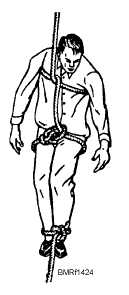REVIEW 9 QUESTIONS
Q1. What is one of the easiest ways to carry an
unconscious person?
Q2. Describe the precautions you should take when
rescuing a person who has received an electric
shock.
Q3. How should you carry a stretcher?
Q4. What type of stretcher is used to transport an
injured person from engine-room spaces?
Q5. When are emergency rescue lines used?
PERSONAL HYGIENE
Learning Objectives: When you finish this chapter,
you will be able to—
Identify the purpose for personal hygiene.
Recognize the consequences of not following a
personal hygiene program.
Because of the close living quarters in the Navy,
particularly aboard ship, personal hygiene is very
important. Developing good personal hygiene habits is
essential for the good health of the individual and for the
protection of the entire crew. For the same reasons,
sanitary conditions aboard ship must be maintained at
all times. Clean spaces are a necessity. Dirt breeds
disease. When spaces are kept clean and orderly, the
general well-being of the crew improves and morale
increases. No one wants to live or work in a filthy
environment. In the Navy and at home, everyone should
make it a habit to keep living and working spaces as
clean as possible. Maintaining a clean, healthy
environment reduces the chances of illness.
Negligence in reporting to the medical officer any
matter that affects one’s health is inexcusable. It can
lead to a more serious illness. Don’t ignore minor
injuries. An untreated cut or scratch can lead to
infection, loss of a limb, and even death. If you can’t
report for treatment right away, wash the injury with
soap and clean water. A large wound should not be
washed; cover it with a clean dressing until it can be
attended to by medical personnel.
Some practices you can take to be healthy include
the following:
Showering. Shower and change underwear daily.
After showering, dry thoroughly, particularly your feet
to prevent fungus development. Wear shower shoes
when taking a shower to avoid contracting athlete’s
foot.
Shoes and socks. Wear properly fitted shoes and
socks. The inner dimensions of the shoe should be about
1/4 inch longer and wider than the foot. Improperly
fitted socks and socks with holes can cause blisters.
Change your socks daily.
14-29
Student Notes:
Figure 14-24.—Emergency rescue line.

